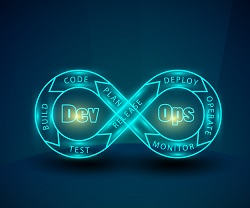
Vipin Choudhary
 An organization ready to undertake a digital journey often fails to keep newly implemented systems robust and flexible enough to adapt to new technologies. Despite countless DevOps solutions and setting up a close collaborative culture between development and operations, in a majority of cases, we forget to bring continuity to the process with regular feedback. DevOps can get us on the right track to achieve the vision of digitization, however to transform legacy code into a more distinct business model as well as build a successful agile delivery framework, we need Continuous DevOps.
An organization ready to undertake a digital journey often fails to keep newly implemented systems robust and flexible enough to adapt to new technologies. Despite countless DevOps solutions and setting up a close collaborative culture between development and operations, in a majority of cases, we forget to bring continuity to the process with regular feedback. DevOps can get us on the right track to achieve the vision of digitization, however to transform legacy code into a more distinct business model as well as build a successful agile delivery framework, we need Continuous DevOps.
When it comes to “Continuity”, we need to give a new path to our DevOps implementation and the first place to start is by designing a DevOps approach with a long-term, hybrid vision. For example, defining processes that can adapt to new changes, ensuring tool integration is flexible enough to adapt to the technology change, identifying whether DevOps is being considered as a single implementation or as a set of upgrades at different layers, understanding dependency on the integrated systems, and more.
In a continuously evolving, increasingly digitized world, here are 4 key questions to be answered for a continuous and successful DevOps implementation.
Are we still measuring the maturity of different components with a common maturity model?
We live in a world of multi-speed IT where each layer emerges at its own speed depending on the nature of the audience and the need for it. Frequent releases don’t mean that modifications are required at every level. For example, we see several user interface (UI) changes on Facebook on a regular basis, but this does not mean that every associated component, say a database, is updated at the same pace.
Are there separate KPIs for each level?
Determining how we measure our success is as important as getting that success. So defining KPIs is important. But are we defining KPIs that are smart enough to handle DevOps implementations at every level or for each component?
For instance, DevOps comprises of a set of practices, but does that mean that we define a single approach for different layers of a software delivery model? We should not. Every component has its own lifecycle and implementation, when it comes to back end systems, front end, core components or any other supporting tools, each of these need to have separate KPIs.
Is there proper orchestration of tools?
What if you are listening to an orchestra and the flute is creating noise instead of mesmerizing music? With good orchestration, a rhythm is created that enhances every musical note. DevOps orchestration is somewhat similar. It is a process of understanding and combining the benefits of multiple tools used in a project. There are various tools such as JIRA for bug tracking, Bitbucket for version control, Jenkins or Bamboo as build servers, Puppet/Chef for configuration management, ITSM for operations, and Splunk for better monitoring. With a proper orchestration process or tool in place, we can combine the benefits of all. For example, three separate software development tools such as JIRA, BitBucket and Jenkins must be integrated in a manner that change in one system should update the other system.
Is there an extra layer of security?
Whenever we automate a software development process, we are inadvertently adding a new layer of security with each step. It not only reduces manual intervention but also reduces the risk of tampering the actual process. Let’s take the example of payment gateways. Till some time back a username, password or pin was required to validate transactions, but Apple Pay or payment via fingerprint scans is commonplace now.
Of course, finally the biggest consideration is how to improve the DevOps ecosystem. Let us illustrate this with an example of Application Portfolio Rationalization (APR) where an organization tries to gain control over a number of isolated applications. Majority of these initiatives fail while gaining control over the application portfolio due to lack of discipline, different project delivery plans and aggressive timelines. DevOps plays an important role in setting up one common goal as a single product approach focusing on integration of different systems, which are independent in nature. We can create a much cleaner ecosystem and ensure smooth integration using customized tools and processes. For instance, setting up a process in which we can wrap every component of our ecosystem (either in Microservices or Containers) so that the synchronization between different systems is seamless.
With successful DevOps, we can reap a number of benefits, from building the right product to enhanced quality to reduced costs. But remember, in a digitized world, continuity is a necessity and without Continuous DevOps today’s digital could be tomorrow’s legacy.




